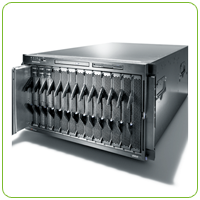
After experiencing a number of production roll-outs, on both blade and rack mounted servers, I began to think about the advantages of one over the other. In general, blade servers sounded like a better approach, but it appears to be more of a marketing hype than reality. I’m not a hardware or infrastructure expert, but my comments are based on my experience in rolling out enterprise applications to various organizations and below are some of my thoughts about blade servers.
1. Blade servers are more expensive. To setup a blade server, you’ll need to purchase a chassis. The price of the chassis alone is already comparable to 2 rack mounted servers. On the average, the price of blade server setup is about 20%-30% higher than a comparable rack mounted server setup. Unless of course, you get to fill-up the entire chassis with 14 blades.
2. Blade servers are less powerful. Processor configurations on blade servers are less powerful than their rack-mounted counterparts. How much processor can you really put into that small form factor? Blade servers are also known for smaller disk capacity because its designed to use SAN storage.
3. Blade servers are not fail-safe. Contrary to the popular belief, blade servers are not fully-redundant (at least the once I’ve seen). Each blade connects to a blade controller which is a single point of failure, if that controller fails, then all blade fails. Some chassis also uses a single power supply, thereby – another single point of failure.
4. Blade servers cannot be super computers. No you cannot combine multiple blades and make them into one single super computer. At least not without the right software. But with the right software, you can also achieve the same on rack mounted servers.
5. Virtualization is not only for blade server. Virtualization can also be set-up on multiple rack servers. Virtualization is a software-based technology and is not hardware dependent. Blade servers + Virtualization is a fuzz.
6. Blade servers are restrictive. Since blade technologies differ from vendor to vendor, adding new processors require purchase of blades from the same vendor. You are even restricted within the blade model supported by the chassis.
Bottom-line: I had high expectations on blade servers and got disappointed with the results. Get your facts straight from the technical merits of using blade servers than listening to the marketing hype presented by that salesperson in a nice suit.


One thought on “Blade Servers : Are they worth it?”
Blade servers are an ideal fit if the requirement is to boot from a Storage Area Network (SAN). When booting from the SAN, no internal disk is required because the host performs a Preboot Execution Environment (PXE) start up from the network, and then connects to the SAN disk where all of its files are located to continue the boot process.
Eventually, more often than not the choice between blades and rack servers comes down to a combination of budget and the type of server already in use in the existing data center.